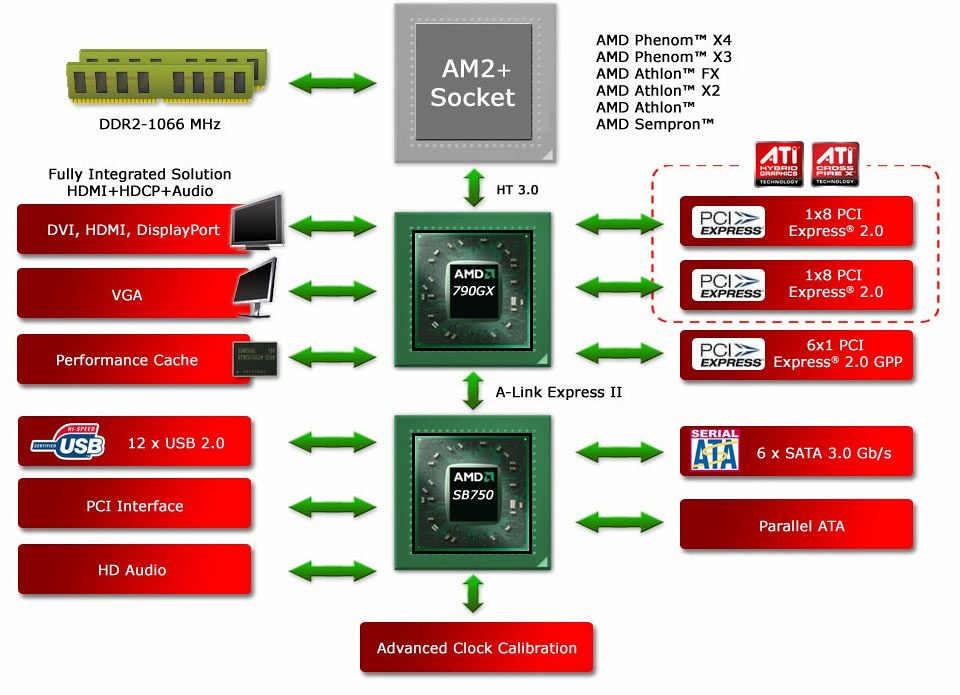Graphics Boosted: 790GX's Side-Port Explored
AMD 790GX Chipset With Side Port Memory
AMD’s latest chipset with integrated graphics is also the high-end product for enthusiasts. The 790GX is meant to fulfill both needs. 790GX motherboards work with the latest southbridge model, called the SB750. The SB750 offers six AHCI Serial ATA/300 ports with command queuing and RAID 5 support, and 12 USB 2. 0 ports. It also has one ATA/100 channel, which Intel threw overboard for the current chipset generation. A high definition audio controller and 32-bit PCI connectivity are considered mandatory today and are also present.
The 790GX northbridge is a 55 nm Flip-Chip Ball Grid Array (FCBGA) device with 528 contacts. It offers HyperTransport 3. 0 support for all modern Phenom and Athlon processors (Ed. —in addition to next-generation Phenom IIs) , 16 PCI Express 2. 0 lanes for graphics, and six single PCI Express 2. 0 lanes for peripheral devices, such as the network controller, which is not part of the chipset, and other add-on cards. The 16 lanes for graphics can be evenly split between two physical x16 slots running in x8 link mode for CrossFireX support, and several options that are related to it.
Graphics Options
All 790GX motherboards come with integrated Radeon HD 3300 graphics—whether you want them or not. This graphics core is based on the RV610 and now runs its 40 unified shaders at a 700 MHz clock speed (that can be overclocked, though) . Should your motherboard manufacturer implement the side-port memory option, then the board will come with additional DDR2 or DDR3 memory. In addition to that, the core can access up to 512 MB of your DDR2 main memory to store graphics data.
The graphics core is DirectX 10-capable, and supports smooth 1080i Full HD playback of all common codecs. This works even with a rather slow Sempron processor. AMD supports DVI and HDMI with HDCP, Display Port and VGA display interfaces, providing maximum flexibility to its motherboard manufacturer partners. Paired with additional AMD graphics cards, you get the following options :
- Running one additional Radeon HD graphics card (up to a Radeon HD 3470) allows the enabling of Hybrid CrossFire, which combines the rendering power of the 790GX with its Radeon HD 3300 and the extra graphics card to accelerate 3D performance.
- Running an additional Radeon HD 3650 or faster will shut off the integrated Radeon HD 3300 core and run only the additional card.
- Running two additional Radeon HD cards—preferably high end models—shuts off the integrated Radeon HD 3300 core and allows you to take advantage of ATI CrossFireX graphics to maximize 3D performance.
- Running two Radeon HD4870 X2 will disable the integrated graphics unit and run the two dual-GPU cards in CrossFireX mode.
AMD Overdrive
AMD’s Overdrive feature was designed to assist in overclocking by allowing the user to modify processor parameters such as clock and system frequencies and voltages in real time, to optimize results. It also allows the Windows-based configuration of memory parameters and comes with comprehensive monitoring options. AMD put all the features into its Overdrive application, which lets you manage your overclocking attempts through a nice interface. Auto and beginner modes assist those who are less experienced with voltages and timings, and on the whole the tool is extremely flexible and powerful : check out the AMD website for more details.
Get Tom's Hardware's best news and in-depth reviews, straight to your inbox.
Current page: AMD 790GX Chipset With Side Port Memory
Prev Page AMD’s Side-Port Memory: Value Or Nonsense? Next Page Jetway HA07 Ultra-LF